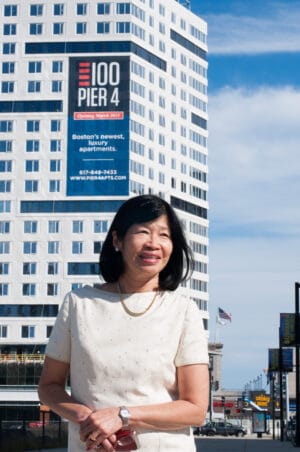Vivien Li
Former president, Boston Harbor Association
Industry experience: 30 years
Properties alongside Boston Harbor are among the city’s top tourism destinations, recreation spots and sought-after business addresses in the 21st century, but in previous generations, Boston largely turned its back on the waterfront. That began to change in the 1980s with the court-ordered upgrade of wastewater treatment systems to meet Clean Water Act requirements, a development boom in South Boston and rising demand for public access and upgraded park networks. Vivien Li was responsible for marshaling support from developers and elected officials to turn the vision of a world-class waterfront into reality during her 24 years as president of the Boston Harbor Association.
Q: What was the Boston Harbor Association’s original mission?
A: The model always was to promote a “clean, alive and accessible” Boston Harbor: the ocean alive with creatures and activity on the waterfront that was accessible to all people. When I was there, what I found really interesting was that regardless of whether you were a Democrat or Republican, everybody supported the clean-up of Boston Harbor and maintaining the beaches and waterfront as accessible to all. [Former Massachusetts House Speaker] Tom Finneran would talk about lifeguarding on Boston Harbor as a kid. [Former Massachusetts Senate President William] Bulger was instrumental in getting put in the budget in the middle of the night $30 million for the “Back to the Beaches” program.
Most middle-class families didn’t have second homes, and the beaches were where everyone hung out. When the automobile and cheap gas made it possible for people to go further for their vacations, then you didn’t have the constituency for the beaches in Boston. It became the place where people of color who didn’t have other options hung out, and there was conflict between people of different races at Carson Beach. With the “Back to the Beaches” [public works improvements] program, today if you go to Pleasure Bay you’ll see people of all backgrounds.
Q: How did private developers respond to the Boston Harbor Association’s goals?
A: One of the things I thought of when I was preparing for this interview was the role that public investment contributed to the renaissance of the waterfront. [Developer] John E. Drew was the one pushing for the MBTA Silver Line. Now think about how many employees in the Seaport take the Silver Line. When we first talked about it, there was nothing there but these cheap parking lots. But he had worked in Mayor Kevin White’s administration, and he knew how long it took to get federal dollars for any project. The two developers who to me were key partners were [Rowes Wharf developer] Ed Sidman and John Drew.
Some developers would say [public benefits] were too expensive. Water transportation saved us during the financial crisis in the 1980s. People were getting off the ferries and going to their offices and going to the restaurants and bars after work. Ed Sidman understood that. The idea of a more robust water transportation system is really key as we build out the waterfront.
Q: What was the first segment of the Boston Harborwalk to be completed?
A: Christopher Columbus Park was pretty key. The North End neighborhood really made the waterfront part of the community. It was very different in South Boston, which was industrial uses: the fish pier, warehousing, parking. The traditional South Boston neighborhood viewed it as a place to work.
 Q: The lack of economic and racial diversity is a frequent critique of the Seaport District. How did the housing planning reflect the public comments in the early stages of the development?
Q: The lack of economic and racial diversity is a frequent critique of the Seaport District. How did the housing planning reflect the public comments in the early stages of the development?
A: In East Boston, they required that affordable housing be included on the waterfront. In South Boston, the elected officials said they wanted the affordable to be off-site in the traditional South Boston neighborhood. That’s why we don’t have the affordable component on the South Boston waterfront, so it really is luxury housing. The developers paid in, and they agreed to what the community wanted at the time. The developers bent to the will of the community. I wish we had thought more about that mix.
Q: How can the city and developers put together a strategy to protect the developments on the waterfront in the age of rising seas?
A: The average property owner still thinks about his or her property and what are their requirements. There has been in the past a mistrust of government contributing: “I can do it better myself.” I think now in this decade going forth, most developers have to partner with those to their right and their left, and they need help from the government. Bryan Koop from Boston Properties and I used to do presentations after Hurricane Sandy. They own properties in New York that were flooded from Sandy and they had to relocate tenants, and their buildings were out of service for months. You should have seen other developers watching this Powerpoint speechless.
Q: What are some examples of unfinished business for the waterfront?
A: The Harborwalk obviously is more than 80 percent complete. In the marine industrial area, you want to make sure the areas are safe for people to walk, with the trucks backing out of loading zones. It doesn’t require a full Harborwalk, just access points. We may never get 100 percent access. There are still opportunities in Dorchester, where there’s now a greater focus on development. There is a dock at UMass Boston that is owned by the state Department of Conservation of Recreation that is only used in a limited way. That dock is one we pushed for strongly, because at some point you may want to use it for people commuting from Dorchester to other parts of the city.




 |
| 


